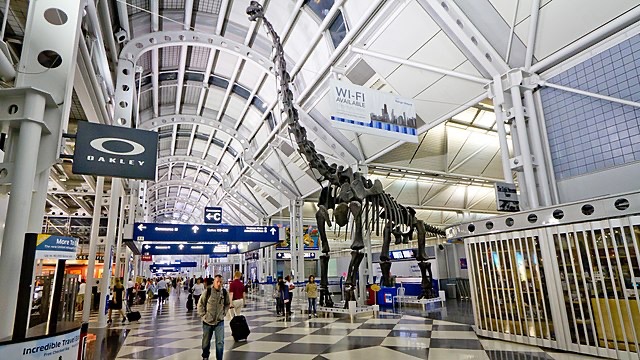Health authorities have issued a public health alert following a confirmed case of measles at Chicago O’Hare International Airport, one of the world’s busiest air travel hubs. An adult infected with the virus passed through Terminal 1 on April 22 and 23, potentially exposing hundreds of travelers to what is considered the most contagious disease on the planet.
This case has put the U.S. on red alert, highlighting the fragile state of vaccine-preventable disease control in a post-pandemic world.
When and Where Exposure Occurred
The infected traveler was present in Terminal 1 of Chicago O’Hare Airport on:
- April 22 from 10 a.m. to 8 p.m.
- April 23 from 10 a.m. to 8 p.m.
This terminal services numerous major airlines, including United Airlines, with thousands of passengers transiting through during that timeframe. Officials warn that anyone in the terminal during these hours may have been exposed, even without direct contact, due to the airborne nature of measles.
Additional Public Locations Impacted
In addition to the airport, the same individual visited the following public venues while contagious:
- Chicago Public Library – Independence Branch (April 21)
- Fittingly Delicious Cafe (April 21)
- Aldi in Lyons (April 25, 10 a.m.–12:30 p.m.)
- Shell Gas Station in Stickney (April 27, 10 a.m.–12:30 p.m.)
- Mobil Gas Station in Berwyn (April 28, 10:20 a.m.–1 p.m.)
Residents who were present at these locations during the specified times are urged to contact their healthcare providerand monitor symptoms for up to 21 days after exposure.
Measles: The World’s Most Contagious Virus
Measles is caused by the rubeola virus and spreads through respiratory droplets. It is so contagious that 90% of unvaccinated people exposed to it will become infected.
Symptoms typically appear 7 to 14 days after exposure and include:
- High fever
- Runny nose and cough
- Red, watery eyes
- A distinctive red rash that spreads from head to toe
Airborne Risk and High Contagion
Measles can linger in the air up to two hours after an infected person has left. This means passengers who walked through Terminal 1 after the infected traveler had already left could still be at risk.
The Centers for Disease Control and Prevention (CDC) ranks measles as one of the most infectious diseases known to humanity—far more contagious than COVID-19.
Health Officials Sound the Alarm
The Illinois Department of Public Health (IDPH) and Chicago Department of Public Health (CDPH) are now conducting contact tracing and urging recent travelers to:
- Review their MMR vaccination history
- Seek immediate medical advice if symptoms develop
- Avoid public places if symptoms are suspected
Health departments are prioritizing communication with local clinics, airports, and schools to prevent further spread.
MMR Vaccine: The First Line of Defense
Vaccination remains the most effective protection against measles. The MMR vaccine (measles, mumps, rubella) is 97% effective with two doses and has virtually eradicated the disease in the U.S.—until recent resurgences linked to declining vaccination rates.
The CDC recommends:
- All children receive two MMR doses (first at 12–15 months, second at 4–6 years)
- Unvaccinated adults and international travelers ensure they’re immunized
- Infants traveling internationally get early vaccination starting at 6 months
Potential Public Health Fallout
If even a small number of exposed travelers were unvaccinated, this case could spark a chain of infections not only in Chicago but across the U.S., as people return to their home states or countries.
In 2019, a similar exposure at LAX led to over 1,000 monitored cases. The CDC and WHO have warned that global vaccine hesitancy could reverse decades of progress against measles.
Conclusion
This incident is a stark reminder of how fast and wide infectious diseases can spread in a globalized world. With the right precautions—vaccination, awareness, and timely response—outbreaks like this can be contained. But without vigilance, they can spiral.
If you were at Chicago O’Hare Terminal 1 on April 22–23, or at the listed venues on surrounding dates, act now: check your vaccine records, monitor for symptoms, and consult your doctor.
FAQs
Q1: How do I know if I’ve been exposed to measles at O’Hare?
A: If you were in Terminal 1 between 10 a.m. and 8 p.m. on April 22 or 23, you may have been exposed.
Q2: What should I do if I think I was exposed?
A: Contact your healthcare provider immediately, especially if you have not had the MMR vaccine or are unsure of your vaccination status.
Q3: Can vaccinated people still get measles?
A: It’s rare. The MMR vaccine is highly effective, and even if a vaccinated person contracts measles, symptoms are usually milder.
Q4: What makes measles so dangerous?
A: Besides being highly contagious, it can cause pneumonia, brain swelling (encephalitis), and death, especially in children and the immunocompromised.
Q5: Where can I get vaccinated?
A: Contact your local health department, GP, or pharmacy. Many offer MMR vaccines for free or at low cost.



